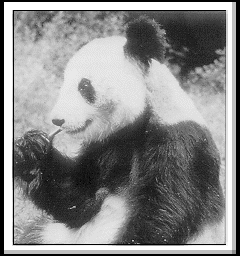




The "Xiongmao" Bear
"Xiongmao", the Chinese name for the giant panda means "giant cat bear". Chinese books, written over 3,000 years ago, talk of the giant panda. Even then, it was believed to be endowed with mystical powers capable of warding off natural disasters and evil spirits. The scientific name for giant pandas, Ailuropoda melanoleuca, simply means black and white bear.
For centuries, the giant panda bear has been considered to be very special and was kept in captivity as the pet of ancient Chinese emperors. Since its introduction to the western world in 1869 by a French missionary who shipped back a pelt to the Museum of Natural History in Paris, it has become the most revered animal in all the world.
Giant pandas are found exclusively in far western China.
In 1984, due to its dwindling numbers, the U.S. Fish and Wildlife Service listed the giant panda as an endangered species under the Endangered Species Act. This means it is considered in danger of extinction throughout all or a significant portion of its range. This protection also prohibits giant pandas from being imported into the U.S. except under certain conditions.
The giant panda is also protected under the Convention on International Trade in Endangered Species of Wild Fauna and Flora (CITES), a treaty among more than 120 nations aimed at controlling illegal trade in endangered animal and plant species. The U.S. Fish and Wildlife Service is the is the federal agency responsible for the U.S. government's compliance with CITES.
The U.S. Fish and Wildlife Service also supports panda conservation efforts in China through funding and technical assistance that includes resource management, research, and educational programs.
The US Fish and Wildlife Service Homepage
In 1869, a French missionary and naturalist named Pere Armand David was the first European to describe the giant panda. In 1936, clothing designer Ruth Harkness brought the first live giant panda, named Su-Lin, out of China and to the West. Su-Lin lived at Chicago's Brookfield Zoo and was a celebrity until he died in 1938. Today, more than 100 giant pandas are found in Chinese zoos, and several others are housed in North Korean zoos. Only about 15 giant pandas live in zoos outside of China and North Korea. In 1980, the first giant panda birth outside China occurred at the Mexico City Zoo.
Until recently, Washington, DC's National Zoo housed Ling-Ling and Hsing-Hsing, perhaps the most well-known giant pandas in North America. A gift from the People's Republic of China to the people of the United States, they were presented as a gesture of amity and goodwill to President Richard Nixon when he visited China in 1972. Ling-Ling, at age 23, died in December 1992. Ling-ling and Hsing-hsing
 My most favorite picture - Ling-ling after lunch.
My most favorite picture - Ling-ling after lunch.
The giant panda is truly a representative endangered species because of the classic problems it epitomizes--large, slow-breeding, specialized vegetarian--that will not survive human impact without human assistance. We, the people, must take strong measures to protect not only this animal but every species and the habitat each depends upon. Everyone of us can make a difference by accepting the challenge to save all plants or animals at risk, whether in our hometown or around the world.

Miscellaneous
Here are some interesting Web site on Giant Panda.

The following has been added by the Electronic Desktop Project:
 Contact Us
Contact UsIf you are an educator who is using our NEXTSTEP or virtual applications in the classroom, we would especially like to hear from you. Let us know what you are doing and how it is working out. Continued support for this project will depend on its impact in science education.
If you are an educator who is interested in making use of our NEXTSTEP or virtual applications, please let us know how we can help.
 Return to the Electronic Desktop Project home page
Return to the Electronic Desktop Project home page
![]() Check out the WWW Virtual Application Catalog from the EDP
Check out the WWW Virtual Application Catalog from the EDP
 Check out the NEXTSTEP Application Catalog from the EDP
Check out the NEXTSTEP Application Catalog from the EDP
 Visit the home page for California State University, Los Angeles
Visit the home page for California State University, Los Angeles